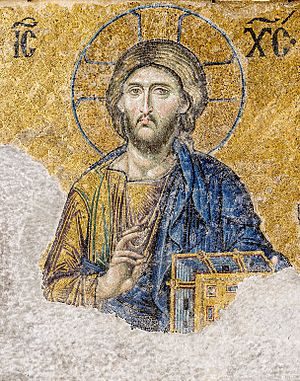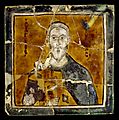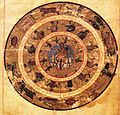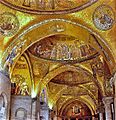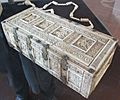Byzantine art facts for kids
Byzantine art means the Christian Greek art of the Eastern Roman Empire from about the 5th century until the Fall of Constantinople in 1453. (The Roman Empire during this period is known as the Byzantine Empire.)
But the term can also be for other the art of countries who shared their culture with the Byzantine Empire. This can include Bulgaria, Serbia, and Rus. The Republic of Venice and Kingdom of Sicily, can also be included even though they were part of western European culture. Art produced by Balkan and Anatolian Christians who lived in the Ottoman Empire is often called "post-Byzantine." Certain traditions that began in the Byzantine Empire, particularly icon painting and church architecture, are still current in Greece, Russia and other Eastern Orthodox countries.
Related pages
Images for kids
-
Icon of the enthroned Virgin and Child with saints and angels, 6th century, Saint Catherine's Monastery, Sinai
-
The Arab Saint Arethas depicted in traditional Byzantine style (10th century)
-
Interior of the Rotunda of St. George, Thessaloniki, with remnants of the mosaics
-
The St. George Rotunda in Sofia, built in the 4th century, and some remains of Serdica can be seen in the foreground
-
Archangel ivory of the early 6th century from Constantinople
-
Mosaic from the church of Hagios Demetrios in Thessaloniki, late 7th or early 8th century, showing St. Demetrios with the bishop and the eparch
-
Helios in his chariot, surrounded by symbols of the months and of the zodiac. From Vat. Gr. 1291, the "Handy Tables" of Ptolemy, produced during the reign of Constantine V
-
An example of Macedonian-era ivorywork from Constantinople: the Forty Martyrs of Sebaste, now in the Bode Museum, Berlin
-
St Mark's Basilica in Venice, where imported Byzantine mosaicists were succeeded by Italians they had trained
-
Modern Orthodox mural from Israel using a depiction of the Nativity of Christ little changed in over a millennium
-
Interior view with the frescoes dating back to 1259, Boyana Church in Sofia, UNESCO World Heritage List landmark.
-
With images of Cupids (10th century), Walters Art Museum
See also
 In Spanish: Arte bizantino para niños
In Spanish: Arte bizantino para niños


